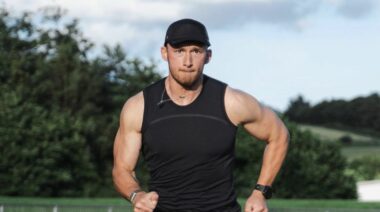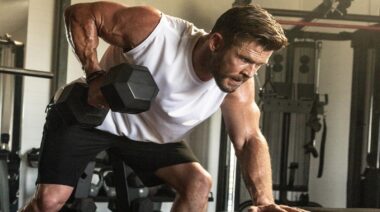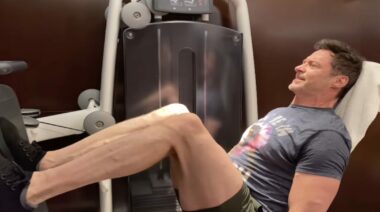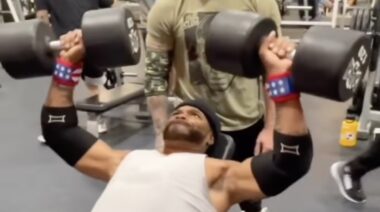The last 5-10 years have seen a rekindled interest in and passion for Olympic weightlifting. Often confused with powerlifting, and sometimes even bodybuilding, Olympic weightlifting is one of the best ways to develop explosive movements for sports, survival, and all-around fitness, which may be why it has seen such a renaissance in recent years.
If any aspect of your fitness regimen involves raw, unadulterated speed, power, and strength, you should consider incorporating the Olympic lifts or their derivatives into your current routine. Before getting started, let’s review some of the potential challenges you may encounter and bad habits you want to avoid in an effort to get a good head start. From there, we will develop a plan for success.
Olympic weightlifting has seen a resurgence in popularity in recent years [Photo courtesy Jorge Huerta Photography]
Start With a Good Coach
Many sectors of the fitness industry, specifically CrossFit and sports performance training, have begun to embrace Olympic weightlifting as part of their programming. This has spawned thousands of instructional videos online. Unless you are a highly skilled and experienced athlete, you simply cannot learn how to perform these movements correctly simply by watching these videos. Even the most accomplished athletes work under the watchful eye and instruction of coaches.
Do yourself a huge favor and hire an Olympic weightlifting coach. Nothing will ever replace the benefits of working with an experienced coach or trainer. Here are a few pointers to help winnow down the candidates.
- Record: The easiest way to evaluate a coach is to research his or her competitive record.
- Feedback: Talk to some of the athletes this coach has worked with and find out about their experiences.
- Credentials: There is no licensing of weightlifting coaches in the United States. However, USA Weightlifting does have a certifying body, and you can check to see if they hold any sort of accreditation.
- Education: A degree in exercise science or some related field is important. A Bachelors or Masters degree in biology, biomechanics, physiology, or anatomy would assure a good formal foundation for a coach’s knowledge base.
- Certifications: Look into a coach’s professional credentials. The CSCS (Certified Strength and Conditioning Specialist) is considered one of the premier training certifications for performance-based conditioning. Other credentials that carry a good deal of respect are the National Academy of Sports Medicine PES (Performance Enhancement Specialist) and the ACSM Certified Exercise Physiologist.
Get the Gear
Olympic Weightlifting Shoes
Once you have a good coach, you need to get the correct equipment. Shoes are perhaps your most important purchase. Olympic weightlifting shoes are not just any ordinary shoe. There is a purpose for their unusual design and appearance.
- Hard, flat sole: The soles used to be made of wood, but companies today often use a hard plastic sole. The reason for these hard, flat soles is to get as much force off the ground as you can. The soles of regular shoes are slightly squishy and will result in as much as 10 percent loss of power off of the ground.
- Elevated heel: The elevated heel is the game changer when it comes to specialized shoes. Have you even noticed how much easier it is to squat with a raised heel? That’s because the elevated heel allows you to get a fuller range of motion and consequently a deeper squat. People who have tight ankles and hips will see a huge improvement in their ability to squat while wearing Olympic weightlifting shoes. If you don’t believe it, put 5lb plates underneath your heels to mimic a lifted heel, and notice the difference in your position.
- Straps: Straps give your foot a snug fit feeling and keep them from slipping around inside your shoes. You want your feet in a secure and stable positions while performing Olympic lifts and squats.
You can find shoes from brands like Reebok, Adidas, Nike, Do-Win, Risto, and Inov8, and others. Unfortunately, you won’t find these shoes in your local Foot Locker, so it may take a few online purchases before you find the right fit. Purchase them a half size smaller than your running sneakers.
Olympic Weightlifting Bar
Another purchase to consider is an olympic barbell. These bars can cost anywhere from several hundred dollars to as much as $1,000. There are two key aspects to these specialized bars:
- Bar diameter: Olympic competition bars are 25mm in diameter for women and 28mm for men. These diameters have two effects. First, they allow most people to properly perform a hook grip, which is discussed below. Second, the thinner steel is able to produce a “whip.” The whip allows an advanced lifter to use the bar as a spring by taking advantage of the fact that the bar bends under the load and acceleration of the lift and then springs back to its original shape.
- Knurling: The best knurling texture for Olympic lifting is a fine knurl that is not sharp. This is accomplished by closer spacing and deeper cuts than what you would see on a bar from your local sporting goods store. Knurling like this takes precision equipment and is time-consuming to create, which is one of the things that makes bars like this so special.
Fortunately, the growing demand for these bars has brought the price down quite a bit. Today you can find a bar in the $300-$700 range from companies like Rogue Fitness and Again Faster.
Training Accessories
As you search for the right shoes and barbell, you will be tempted to purchase a host of different training accessories. Generally speaking, you can save your money, but if you do decide to make these purchases, here are a few considerations.
- Knee/elbow sleeves: You do not have to purchase elbow and knee sleeves. Although compression gear can provide comfort and warmth, there is no guarantee they will provide additional protection. They certainly will not make you move better.
- Wrist wraps: Wrist wraps might provide a little extra support against strains, especially under heavier loads. However, you would be better served to work on your mobility. Properly mobilizing your wrists, elbows, and shoulders provide a better defense against strains and lead to long-term success.
- Chalk and tape: If the facility you are training in does not provide these consider finding a new facility. If you really like facility despite such a glaring omission, then go ahead and purchase these two items. You will use them virtually every training session and they are cheap.
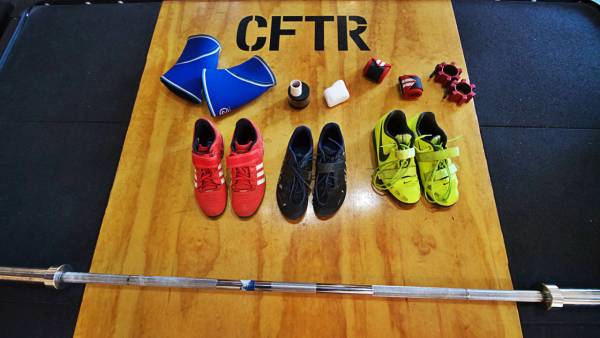
Good shoes and a proper bar are necessary. All the other accessories are optional. [Photo courtesy Dan Sullivan]
Develop Your Fitness Foundation
Now that you have decided to incorporate Olympic weightlifting into your routine, it’s time to start training. It would be naive to assume you can simply walk into a gym and start performing cleans, jerks, and snatches. To focus on such specific and technical movements, you must first develop the broadest fitness foundation possible. Here are the key areas to include in your training:
Squats
The squat trains your basic ability to raise and lower your center of mass. It is a motion essential to all of life’s pursuits. The real-world application, the expression of posterior chain strength and flexibility, and the need for spinal stabilization during execution create an incredibly functional and intense movement.
Squats increase bone density and train the core muscles to eliminate unwanted movement. They allow for large loads to be moved quickly, which is essential for strength and power gains. Finally, the squat prompts a strong neuroendocrine response that releases hormones essential to growth, strength, and metabolism.
Core
Your core is comprised of all the muscles between your hips and shoulders. Some of these muscles, such as the rectus abdominus and hip flexors are fairly familiar, but not everyone has heard of their transverse abdominus or their erector spinae muscles. Each of these muscles deserve proper attention and training. A strong core leads to increased movement efficiency, better body control, and coordination.
Most muscles within the core are designed to eliminate unwanted movement. If you only train these muscles to perform flexion, then they will be unable to handle the stresses of movements like the overhead squat, which requires tremendous midline stabilization. When performing core-to-extremity movements, the muscles of the core must fire in a controlled and coordinated fashion. This is developed through proper mobility and stability training.
Hook Grip
The hook grip is a method of holding a barbell by gripping the thumb between the barbell and the remaining fingers. The hook grip can be tricky initially, especially for individuals with smaller hands, and even more so for individuals whose hands are thick. However, there is a reason every weightlifter in the world uses the hook grip: when you are accelerating a barbell in the Olympic lifts, you cannot maintain your grip without it.
To set your grip, push the webbing between your thumb and index finger into the bar as deep as possible, and then wrap the thumb and fingers. Do not just pinch your thumb between your fingers and the bar. Instead, wrap your thumb around the bar, then grab your thumb with your first two fingers and pull it farther around the bar. There is some stretching that needs to occur before the hook grip feels secure. The best way to accomplish this is to use the hook grip every time you pull a bar, even during heavy deadlifts. Taping your thumbs is another option that can create a little additional friction on the bar to make your grip feel more comfortable.
Grip Strength
To improve your grip strength, start by manipulating thick barbells – tire axles, fat bars, or even wrap a thick towel around a traditional barbell. Use this thicker bar once every other week for deadlifts. Aim for 10-20 reps in the beginning, but work your way up to your one-rep max as your grip strength develops.
Farmer’s walks also improve grip strength. Grab two dumbbells or kettlebells of decent weight and carry them for at least 100 meters. When that gets too easy, load up two barbells and carry them the same way. Next, try pinching weight plates between your fingers. If you are stuck in an office during the day, buy a pair of hand grippers. Make sure the pair you get has enough resistance that five repetitions at a time is initially challenging. Finally, work your extensor muscles by wrapping a rubber band around your fingers and spreading your fingers as wide as possible.
Jump
If you want to become as explosive, you must train explosively. Too often people focus on the technical lifts and get bogged down with progressions that have a steeper learning curve. These progressions are important to learn, but your time initially can be better spent working on something more basic and effective.
Jumps are directly applicable in most sports, and are an awesome display of relative strength, power, and raw athleticism. Once coordination, landing mechanics, and jumping technique are sufficient, add both height and weight to your jumps. Box jumps are preferable for two reasons. First, landing on a higher surface as opposed to the ground eliminates the added stress of gravity, so you can train harder with less risk of injury. Second, it is easier to measure progress when comparing heights. You can also add weight to make the jumps more challenging by holding dumbbells or using a weighted vest.
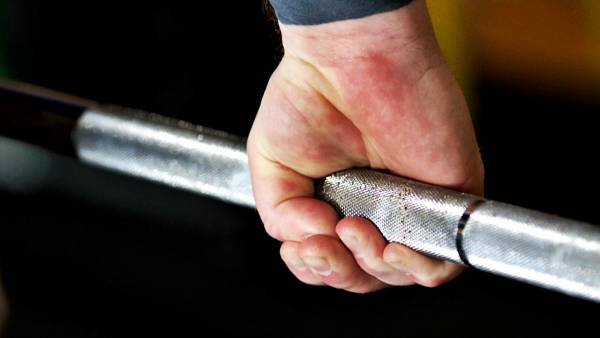
The hook grip allows you to move heavy loads explosively without flying off the bar. [Photo courtesy Dan Sullivan]
Recovery Is Part of Your Training
Recovery is a huge topic, but it is worth mentioning a few key elements:
- You are what you eat: Lean protein will support muscle growth and repair. Fruits and vegetables will provide antioxidants to protect against cellular damage and reduce inflammation.
- Drink: Stay hydrated. Drink at least half an ounce of water per pound of body weight per day and even more on hot and humid days.
- Sleep: Your body regulates the hormones that affect how your muscles adapt to training during your sleep cycle. Depriving yourself of the recommended eight hours of shut eye is a sure-fire way to strip yourself of some much needed recovery.
- Cool Down: When your workout is complete, walk around a little bit or jump on the rower to keep circulating blood and nutrients through the body. Then do some light stretching. Your muscles will feel less stiff and sore afterward.
Much More to Learn
This guide is only the tip of the iceberg when it comes to Olympic weightlifting, but it will get you started on the path toward developing explosive power and newfound fitness. Keep it simple, listen to your coach, and don’t overthink your lifts. You’ll probably find the lifts a little uncomfortable at first, but the magic happens when you leave your comfort zone.
Can’t I just learn weightlifting at my local CrossFit gym? Not really:

